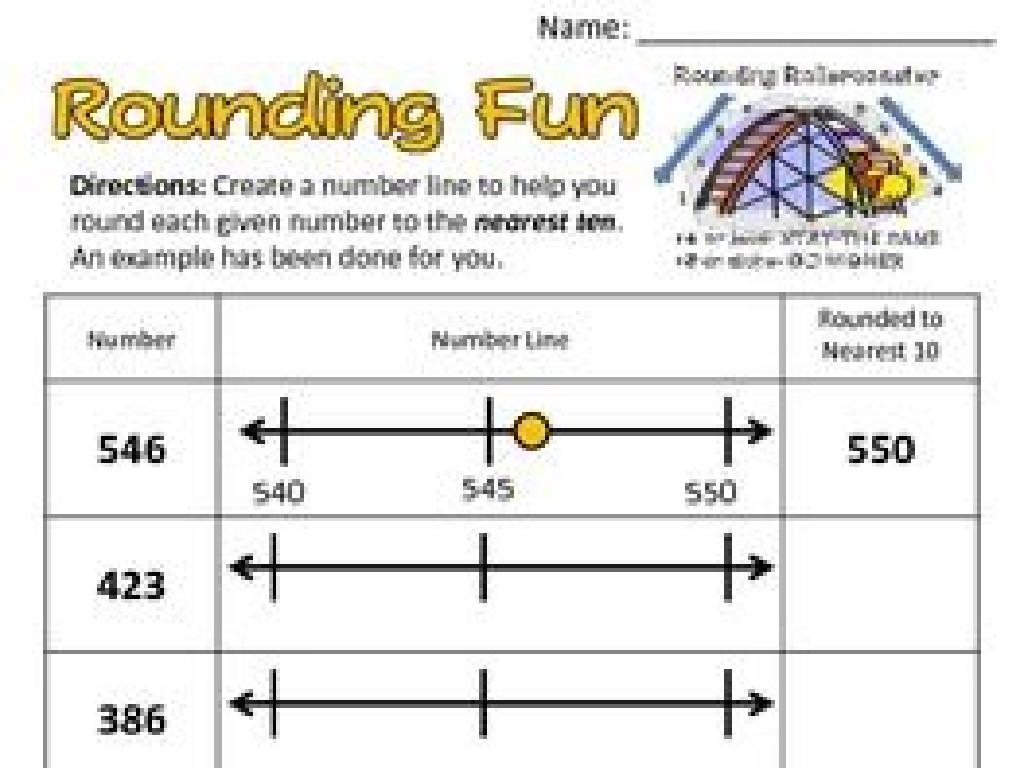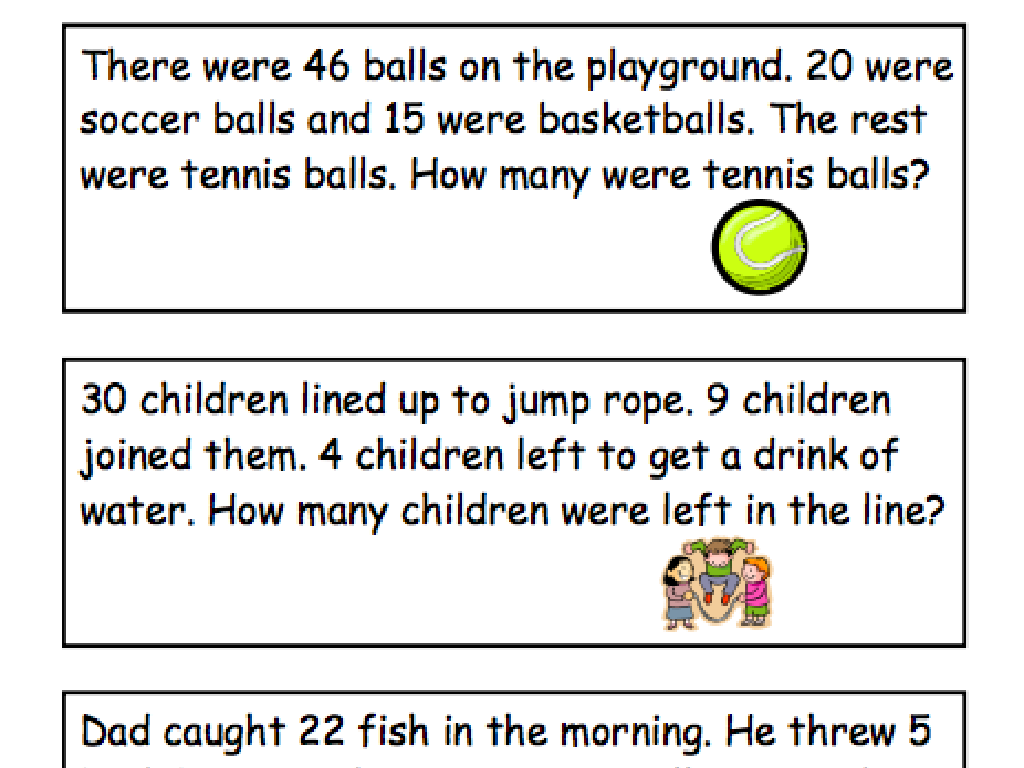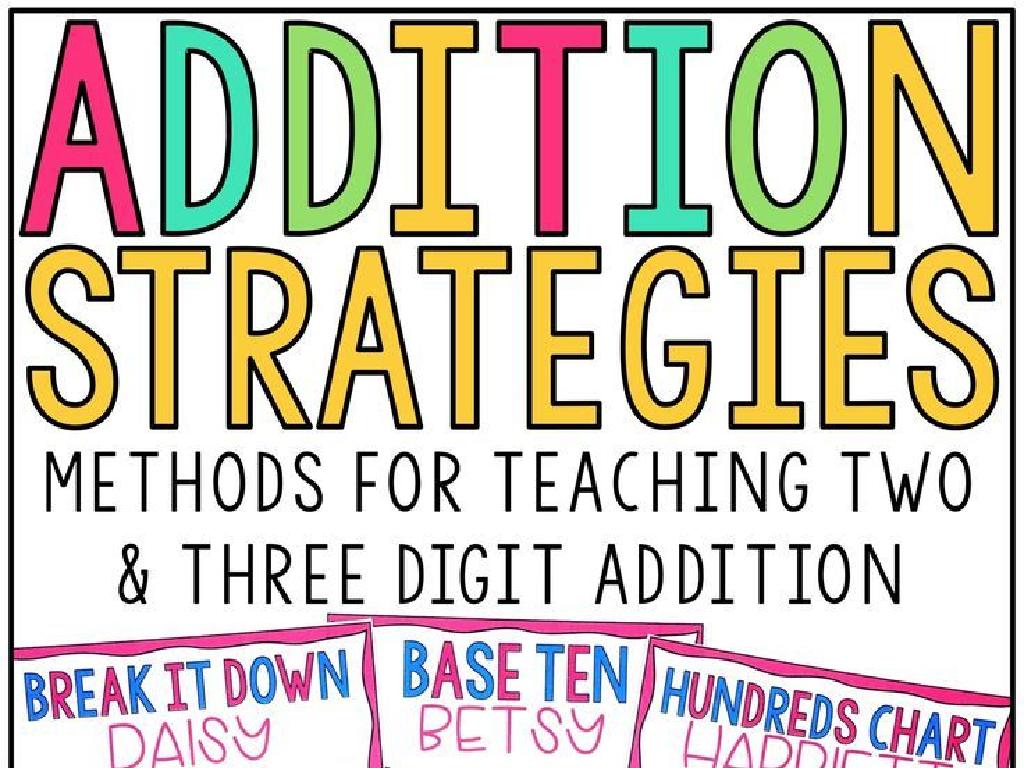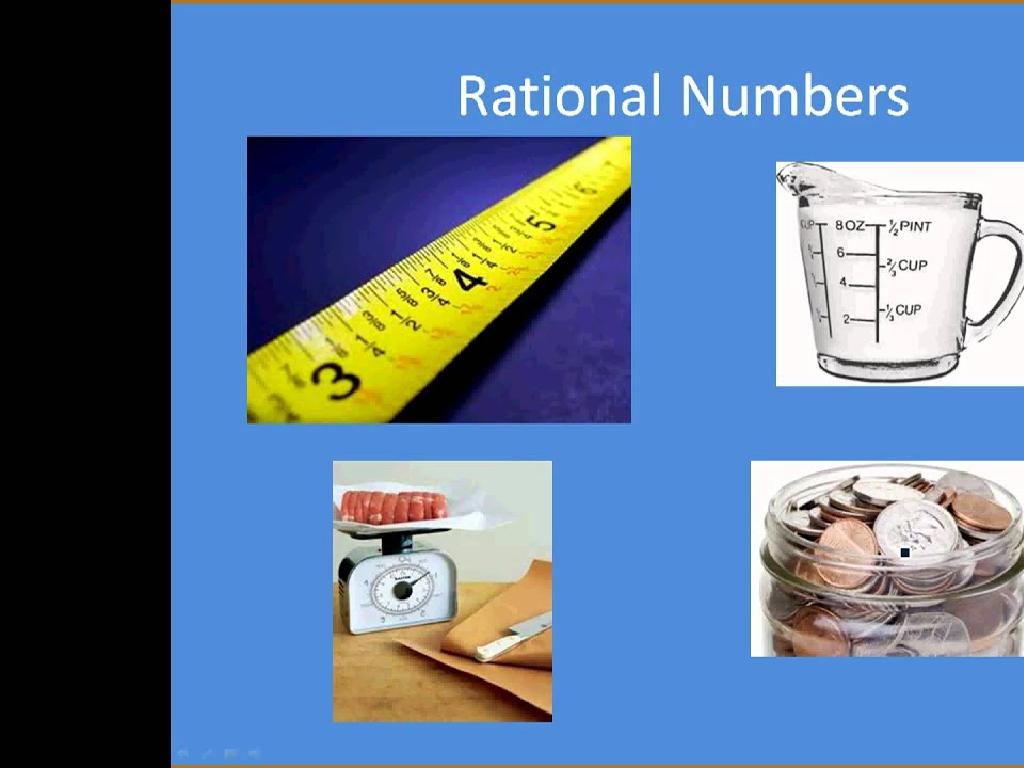Compare Fractions: Find The Missing Numerator Or Denominator
Subject: Math
Grade: Fourth grade
Topic: Compare And Order Fractions
Please LOG IN to download the presentation. Access is available to registered users only.
View More Content
Today’s Adventure: Comparing Fractions!
– Explore numerators & denominators
– Top number (numerator) shows parts we have, bottom number (denominator) shows total parts.
– Learn why comparing matters
– Comparing fractions helps us understand which is larger or smaller in value.
– Find missing numerators
– Use cross-multiplication to find a missing numerator when comparing fractions.
– Discover missing denominators
– Cross-multiply to solve for a missing denominator in equivalent fractions.
|
This slide introduces the concept of comparing fractions, which is a fundamental skill in understanding mathematical relationships. Begin by explaining the roles of numerators and denominators in fractions. Emphasize the importance of comparing fractions in real-life situations, such as determining portions of food or comparing distances. Teach the method of cross-multiplication to find missing numerators or denominators when comparing fractions with different numbers. Provide examples and practice problems to solidify understanding. Encourage students to ask questions and share their methods for comparing fractions.
Understanding Fractions
– A fraction shows part of a whole
– Numerator: Number of parts we have
– If we have 3 out of 4 pieces, numerator is 3
– Denominator: How many parts in total
– If a pizza is cut into 8 slices, denominator is 8
– Finding missing numerator/denominator
– Use multiplication or division to find missing values
|
This slide introduces the concept of fractions to fourth-grade students. A fraction is a way to represent a part of a whole, such as a slice of pizza or a piece of a chocolate bar. The numerator, the top number, indicates how many parts we’re talking about, while the denominator, the bottom number, shows into how many equal parts the whole is divided. Understanding these components is crucial for comparing fractions and finding missing numerators or denominators. To find a missing numerator or denominator, students can use related fractions that they know and apply multiplication or division. For example, if they know 1/2 of a shape is shaded and the denominator is 8, they can determine the numerator must be 4 because 4 is half of 8. Encourage students to practice with different fractions to become comfortable with these concepts.
Understanding Equivalent Fractions
– What are equivalent fractions?
– Fractions with different numbers but the same value
– Example: 1/2 equals 2/4
– Both fractions represent the same part of a whole
– Making equivalent fractions
– Use multiplication or division to find equivalents
– Multiplying or dividing both parts
– Always use the same number for numerator and denominator
|
This slide introduces the concept of equivalent fractions, which are different fractions that represent the same value. For example, 1/2 is equivalent to 2/4 because they both represent half of a whole. Teach students how to create equivalent fractions by multiplying or dividing both the numerator and denominator by the same number. Emphasize that this number must be the same for both to maintain the value of the fraction. Provide additional examples and practice problems to help students become comfortable with finding equivalent fractions through multiplication and division.
Comparing Fractions with the Same Denominator
– Same denominator: easy comparison
– Fractions with the same bottom number (denominator) have equal parts.
– Larger numerator means larger fraction
– If two fractions have the same denominator, the one with the bigger top number (numerator) is bigger.
– Example: Which is larger, 3/8 or 5/8?
– 5/8 is larger than 3/8 because 5 is more than 3.
|
When comparing fractions with the same denominator, we can focus on the numerators to determine which fraction is larger. It’s like comparing the number of slices of pizza each person has when the pizza is cut into the same size slices for everyone. In the example given, both fractions are out of 8, so we look at the numerators 3 and 5. Since 5 is greater than 3, 5/8 is the larger fraction. This concept is fundamental for understanding how to compare fractions and is a building block for more complex fraction comparison. Encourage students to practice with different fractions having the same denominator to reinforce the concept.
Comparing Fractions: Different Denominators
– Find a common denominator
– Make denominators the same
– Equivalent fractions represent the same part of a whole
– Example: Compare 2/3 to 3/4
– 2/3 becomes 8/12 and 3/4 becomes 9/12
– Use equivalent fractions
– Find fractions that are the same value but have the same denominator
|
When comparing fractions with different denominators, it’s necessary to find a common denominator so that the fractions are comparable. Teach students how to find equivalent fractions that have the same denominator. For example, to compare 2/3 and 3/4, we can convert them to have a common denominator of 12, resulting in 8/12 and 9/12, respectively. This allows us to see that 3/4 is larger than 2/3 because 9/12 is greater than 8/12. Use visual aids like fraction bars or circles to help students understand the concept of equivalent fractions. Encourage students to practice this skill with different sets of fractions.
Finding the Missing Piece in Fractions
– Understanding incomplete fractions
– Using equivalent fractions
– Equivalent fractions have the same value, even if they look different
– Example: 1/2 equals ?/4
– To find the missing numerator, multiply the known numerator by the factor that gets you from the known denominator to the missing one
– Solving for the missing number
– We multiply 1 by 2 because 2 times 2 equals 4, so the missing numerator is 2
|
This slide introduces the concept of finding missing numerators or denominators in fractions by using the principle of equivalent fractions. Start by explaining that sometimes we don’t have all the information in a fraction, and we need to find a missing part. Teach the students how to use equivalent fractions to find this missing piece. Use the example provided to show how to find a missing numerator by determining the factor needed to go from the known denominator to the new one. In this case, since 2 times 2 equals 4, we multiply the numerator 1 by 2 to find the missing numerator for the equivalent fraction. Encourage students to practice with different fractions and to always check their work by ensuring the two fractions are indeed equivalent.
Let’s Practice Fractions!
– Find the missing numerator: 3/? = 6/8
– To find ?, multiply 3 by the denominator of 6/8 and divide by 6
– Find the missing denominator: 5/6 = ?/18
– To find ?, multiply 6 by the numerator of 5/6 and divide by 5
– Discuss steps to solve for missing parts
– Cross multiply fractions and solve for the missing number
– Practice with different fractions
|
This slide is an interactive class activity to help students understand how to find missing numerators or denominators in equivalent fractions. Start by explaining the concept of equivalent fractions and the importance of the numerator and denominator. Demonstrate the process of cross-multiplication to find the missing values. Encourage students to apply these steps to the given examples. Provide additional practice problems with varying levels of difficulty to ensure all students grasp the concept. As they work, circulate the room to offer guidance and answer questions. Conclude with a group discussion to reinforce the learning objectives.
Class Activity: Fraction Detective
– Become a Fraction Detective!
– Find missing parts of fractions
– Use clues to determine the missing number
– Pair up for mystery solving
– Discuss strategies with your partner
– Share your findings with the class
– Explain how you solved the fraction mysteries
|
In this engaging class activity, students will work in pairs to become ‘Fraction Detectives’ and solve cases of missing numerators or denominators. Provide each pair with a set of fraction problems where they must use their understanding of equivalent fractions to find the missing values. Encourage them to discuss and apply strategies such as cross-multiplication or using a common denominator. After solving the problems, each pair will present their solutions and explain their reasoning to the class. This activity fosters collaboration and deepens their understanding of fractions. Possible variations of the activity could include creating a fraction puzzle, using fraction cards to match equivalent fractions, or drawing visual representations to find the missing values.
Becoming Fraction Detectives: Conclusion & Homework
– Congrats on learning fraction comparison!
– Review steps to compare fractions
– Remember to find a common denominator
– Homework: 10 problem worksheet
– Worksheet focuses on missing numerators/denominators
– Practice finding missing numbers
– Use clues from known fractions to solve
|
Well done to the class for their hard work in learning how to compare fractions and find missing numerators and denominators. As a recap, remind students of the key steps they’ve learned to compare fractions effectively. For homework, they are assigned a worksheet that contains 10 problems specifically designed to reinforce their skills in identifying missing numerators and denominators within fractions. Encourage them to use the strategies discussed in class, such as finding a common denominator or using multiplication and division to find the missing numbers. This practice will help solidify their understanding and prepare them for more advanced fraction comparisons.






